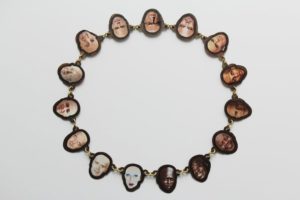
Join us for our weekly BAJ:Insight on the latest industry trends by Rachael Taylor, a freelance journalist who writes about jewellery for a number of titles, including The Financial Times, The Jewellery Editor and Retail Jeweller. In her 10 years reporting on the industry, she has travelled the globe to visit key industry fairs, descended a Fairtrade gold mine on top of a Peruvian mountain, toured silver jewellery factories in Thailand, and regularly has access to the most sparkling jewels and people in the business.

The news of the passing of Ralph Turner, co-founder of The Electrum Gallery, has left me thinking about conceptual jewellery. Turner and his business partner Barbara Cartlidge were the first gallery owners in Britain to champion this style of jewellery when they opened their store in 1971, and the shop continued to do so until its closure in 2012.

Conceptual jewellery should be just that – it should have a concept. While all jewellery has a story and an inspiration behind it, this category takes it further. The jewel is not just an object of beauty (in fact, conceptual jewellery is often purposely not very beautiful at all), but an artist’s statement. The entirety of its form is dedicated to delivering the message it carries and evoking a thoughtful response from the viewer. This intellectual jewellery category first emerged in the late 1960s, and was an extension of the wider conceptual art movement.
One of the conceptual jewellers that Turner chose to support in the early days of The Electrum Gallery was Gijs Bakker, a Dutch designer who became famous for his jewellery creations, despite his loud and regular assertions that he hat ved jewellery. At 75-years-old, the disruptive designer is still provoking people with his jewellery. One of his newest creations, released last year, is a necklace made up of faces of his famous heroes, ranked in order of the colour of their skin. The sliding racial scale starts from a chalk-white David Bowie and ends with a dark-skinned Miles Davis. What spurred Bakker to create this Black to White necklace was concern about rising levels of racial hatred in the Netherlands.

In times of political and social turmoil, which we most definitely find ourselves in right now, art with a message becomes even more important. Another big topic of times is sexism, and a young London-based designer called Samantha Hamilton, who I met with recently, is using her jewellery brand Sam Ham, which launched in September, to make a statement about this. For the most part, her women’s jewels are subtle enough to be wearable and commercial, but each makes a subversive statement by including a precious reproduction of a penis or set of testicles. “They seem pretty important, so I thought I’d add them in there,” she told me, jokingly.

While the subject matter is funny – and indeed her more obvious silver penis pendants on pearl necklaces are a brilliant conversation/caption competition starter – the message is a serious one, passing commentary on a society that seems to put men above women. Her Pretty Dix necklaces are the feminist jewellery equivalent to: if you can’t beat them, join them.
Telephone: +44 (0)20 7405 0197
Company Registration Number:
05992037

Be the first to hear about competitions and giveaways, events, special offers and exclusive discounts, new course dates, and other updates from BAJ and its sister company Free2Learn.